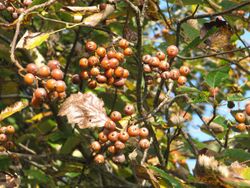Biology:Karpatiosorbus devoniensis
| Karpatiosorbus devoniensis | |
|---|---|

| |
| Devon whitebeam, leaves and young fruit | |
| Scientific classification | |
| Kingdom: | Plantae |
| Clade: | Tracheophytes |
| Clade: | Angiosperms |
| Clade: | Eudicots |
| Clade: | Rosids |
| Order: | Rosales |
| Family: | Rosaceae |
| Genus: | Karpatiosorbus |
| Species: | K. devoniensis
|
| Binomial name | |
| Karpatiosorbus devoniensis (E.F.Warb.) Sennikov & Kurtto
| |
| Synonyms[2] | |
| |
Karpatiosorbus devoniensis is known by the English name of Devon whitebeam[3] and formally as Broad-leaved Whitebeam. When the fruit was reported as sold at Barnstaple Pannier Market [4] the name French Eagles was used, apart from 1929 when they were reported as eagle-berries. When the trees were reported as seen growing wild on botanical walks they were referred to as French Hails (once each as French hail and French Hales). Broad-leaved white-beam, which was the common name until Devon Whitebeam took over, was used once in 1907. The term Otmast was used once as a pet name,[5] as its true identity was not known.[6] The term sorb apple has been used recently but completely without foundation, it is another example of a name being attributed to the wrong species. It is a species of whitebeam, trees and shrubs in the family Rosaceae. It is endemic to the British Isles, growing wild in areas of Devon, Cornwall, Somerset and south-east Ireland as a native and north-east Ireland as an introduction.
It probably did not exist before the last ice age, arising from a hybrid between Sorbus torminalis, the wild service tree, and another species of whitebeam. It is a close relative of the no parking whitebeam, Karpatiosorbus admonitor, and two other British natives and around 40 species in Europe.[7]
Description
It will form a deciduous tree to about 12 metres height.
The leaves are entire, lobed, dark green above, the underside has a dense layer of grey hairs.
It flowers at the end of May, they are white with 5 petals.
The fruits ripen at the end of October. They are orange-brown to brown, and edible.

Locations found
- along the River Taw and River Torridge
- Roborough Down near Plymouth is where the type specimen was taken
- Little Haldon, at Bishopsteignton along the Postman's Path
- Boyton, Cornwall
- South East and North East Ireland (rarely)
- Halsdon Nature Reserve near Great Torrington managed by the Devon Wildlife Trust - a small tree
- Uppacott Wood Nature reserve between Barnstaple and Bideford also managed by the Devon Wildlife Trust, has a few trees
- Watergate Bridge near Great Torrington, grid ref SS468175. The plant growing on the old platform has been removed
- Leigh Cross, Zeal Monachorum
- Watergate, Horwood
- Washington Park Arboretum in Seattle, WA, USA. Some plants in cultivation are incorrectly named so this should be verified
- Between Martinhoe and Lynton in heath and woodland. Importantly not in the East Lyn valley as those plants are Sorbus admonitor
References
- ↑ Beech, E.; Rivers, M.C. (2017). "Sorbus devoniensis". IUCN Red List of Threatened Species 2017: e.T79748504A79748508. doi:10.2305/IUCN.UK.2017-2.RLTS.T79748504A79748508.en. https://www.iucnredlist.org/species/79748504/79748508.
- ↑ The Plant List: A Working List of All Plant Species, http://www.theplantlist.org/tpl1.1/record/rjp-69, retrieved 27 December 2016
- ↑ (xls) BSBI List 2007, Botanical Society of Britain and Ireland, https://bsbi.org/download/3542/, retrieved 2014-10-17
- ↑ Cann, David (2016) Sorbus subgenus Torminaria (Sorbus latifolia agg.) in Devon newspapers. BSBI News No. 133 September pp. 12-17
- ↑ Heligan Survivors ed. Philip McMillan Browse (2009). Alison Hodge. pp 54-55. ISBN 978-0-906720-53-0
- ↑ Browse, P.M.M. (2005), Heligan: Fruit, Flowers and Herbs, Alison Hodge, pp. 88–89, ISBN 9780906720400, https://books.google.com/books?id=D36IWrYiixgC
- ↑ Flora Europaea.
Wikidata ☰ {{{from}}} entry
 |


